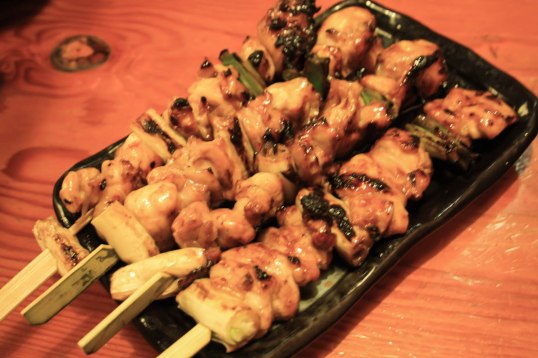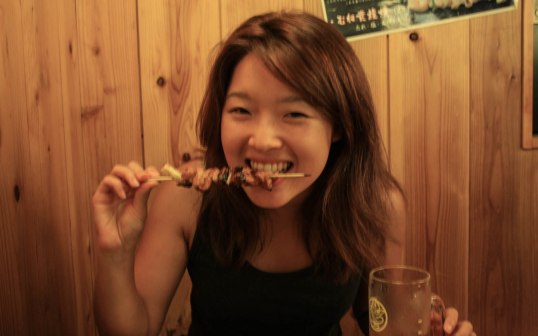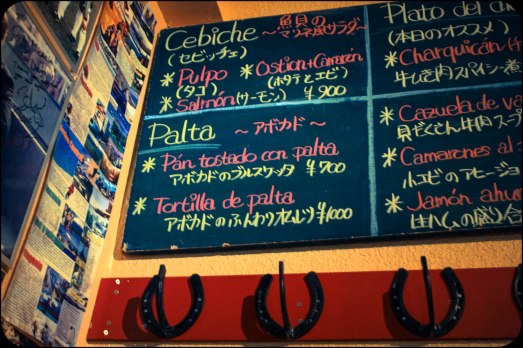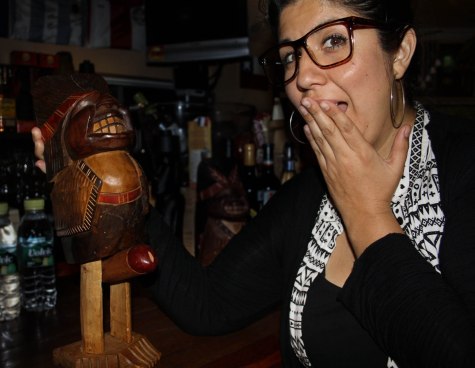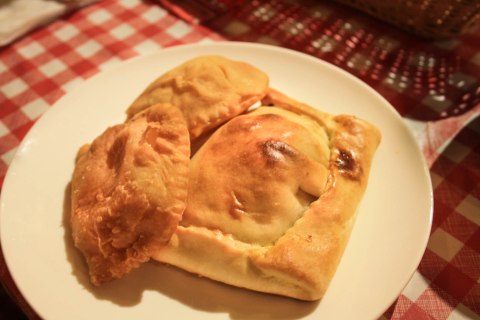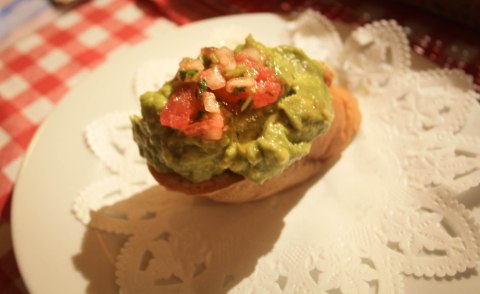One of the best things about living in a share house is that you end up running into people from all over the world. My share house is fairly large, with over 20 people together in one house. About half are Japanese, and the rest foreign, mostly from other Asian countries. One of the first friends I made is Pandora, a rockin’ Argentinian with flaming manic-panic red hair and a deep love for Japan.
Torikizoku – Cheap and Plentiful Yakitori
Steak and cheesy meatballs — everything on the menu is 280 yen
Negima (Chicken and Leek) Brushed with a Soy Ginger Sauce
Beer goes much better with yakiniku than Oolong tea (pictured)
 The steak was definitely the best one
The steak was definitely the best one
Pandora and I went to Torikizoku, a famous chain in Japan, to have Yakitori, or grilled chicken skewers. From their colorful picture menu (really, really useful), we ordered several different kinds of meat cuts and vegetables and launched into a casual discussion about the subtle differences we observed between Japan and our native countries, such as in table manners, communication, work environments, dating, etc.
You know, if people saw this at a restaurant in Argentina, they would freak out.She picked up the damp towelette from the table and dabbed her mouth.
It’s what you use to wipe the kitchen counters. You know what I can’t get used to? People talking with their mouths full. I don’t mind it as much now, but I can’t bring myself to do it. Oh really? It’s actually considered rude here if you don’t. When I was here in high school, I was invited to have dinner with the president of my school. He asked me a question while I was in the middle of chewing and because I didn’t answer immediately, I was chastised–SEVERELY–for being so disrespectful to him. And I was trying to be polite! Something I can’t deal with is the slurping, you know while they eat noodles. Haha, I’m used to that. My dad eats noodles the Chinese way. Still with pasta, I refuse.Gran Micaela y Dago – Chilean Food in Kobe
My friend Kari came into town so we could see off Pandora before she moved to Osaka. We decided to investigate a Chilean restaurant down the hill which we were always so curious about. An American, a German, a Chilean and an Argentinian. As always, I was so excited to eat Latin food.
This second floor restaurant with golden stucco walls was tastefully decorated with Chilean crafts and pictures of the owners with famous visitors. Kari immediately noticed the two, large Indio Picaros, wooden Mapuche Indian statuettes, one of which she eagerly lifted to show us it’s fun “little” secret.
The man behind the counter greeted us first in Japanese, then upon noticing the two Latina women, in fluent Spanish. We let Kari guide us through the menu, since it was all of our first times eating in a Chilean restaurant. We ordered a feast.
My first empanadas since eating Julia’s Empanadas when I lived in Washington, DC.
Pan tostada con palta
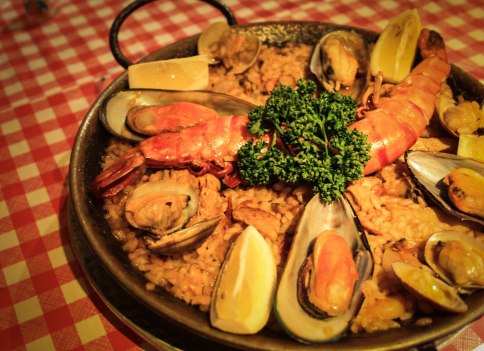 Seafood Paella
Seafood Paella
Raspberry cheesecake with apple icecream
I ate way past the point of being full, but I was so happy. The man who cooked the meal was the owners son, half Chilean, half Japanese, and raised in Japan. He pulled a chair beside us and spoke about growing up here. His father, who speaks very little Japanese even now, made a very strict rule about making the home-life Spanish only, which is why he grew up speaking Spanish. I’m always so fascinated when I meet people who are bilingual, or in this case trilingual. His family gave him the option to attend international school, but he chose Japanese schools because that was where his friends went.
 This restaurant, which has been here for years, often hosts live music nights for regular Latin and Japanese customers.
This restaurant, which has been here for years, often hosts live music nights for regular Latin and Japanese customers.
Nihonjin, Gaikokujin
Working at an international school and meeting lots of foreign residents often keeps me thinking about the issues that surround raising mixed and foreign children in Japan. If parents are lucky enough to have the option, they have to face the difficult question of where to send their kids to school.
Many people I’ve met have said that they are hesitant to choose Japanese schooling. They’ve heard stories of children who have been through the standard Japanese education system and faced some form of bullying due to their foreignness. Sometimes we hear about discrimination based on the fact that a person’s first name is written in Katakana, the Japanese Syllabary used for non-Japanese words. But the option of sending kids to international school is not only expensive, but potentially isolating. Many of the international schools in our area have only a few Japanese students and do not offer adequate instruction of Japanese. What is life like when you grow up in a place where you don’t speak the native language?
That got me thinking about my own experience growing up as a second-generation Chinese in America. Growing up, my family moved around between several major cities along the east coast. Boston, MA, New York City, NY, Edison, NJ, Washington D.C. We never joined any kind of Chinese community. I attended public schools, and never considered attending a Chinese language school. I lost touch with speaking Chinese from a very young age, though eventually I studied it in college.
I often wonder how my life would have been different if my dad made a rule that we had to Chinese at home. Would I have made the same friends? Would I have been interested in the same things? How important is the dominant language used between relocated family members to their experience in the new setting? Would we have retained more cultural practices from China at home?
We thanked our chef for the delicious meal and left to conquer the hill leading back to our share house. I thought about my experience of intersecting nations, and how funny it was that the place I chose was considered the little Europe of Japan.
Want to try it?
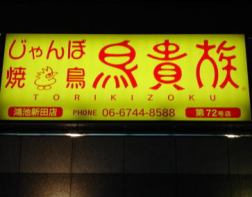 Torikizoku
Torikizoku
There are several locations near Sannomiya, near the Hankyu station, near Ikuta shrine across from Tokyu Hands, and just down the street from the Haagen-datz near the concrete statue park.
+81 78-862-3515
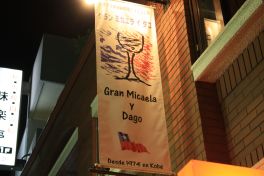 Gran Micaela y Dago
Gran Micaela y Dago
Chilean
2 Chome-13-8 NakayamatedōriChūō-ku, Kōbe-shi, Hyōgo-ken, Japan. Open 5:30pm-midnight. Closed Tuesdays.
078-241-0367

